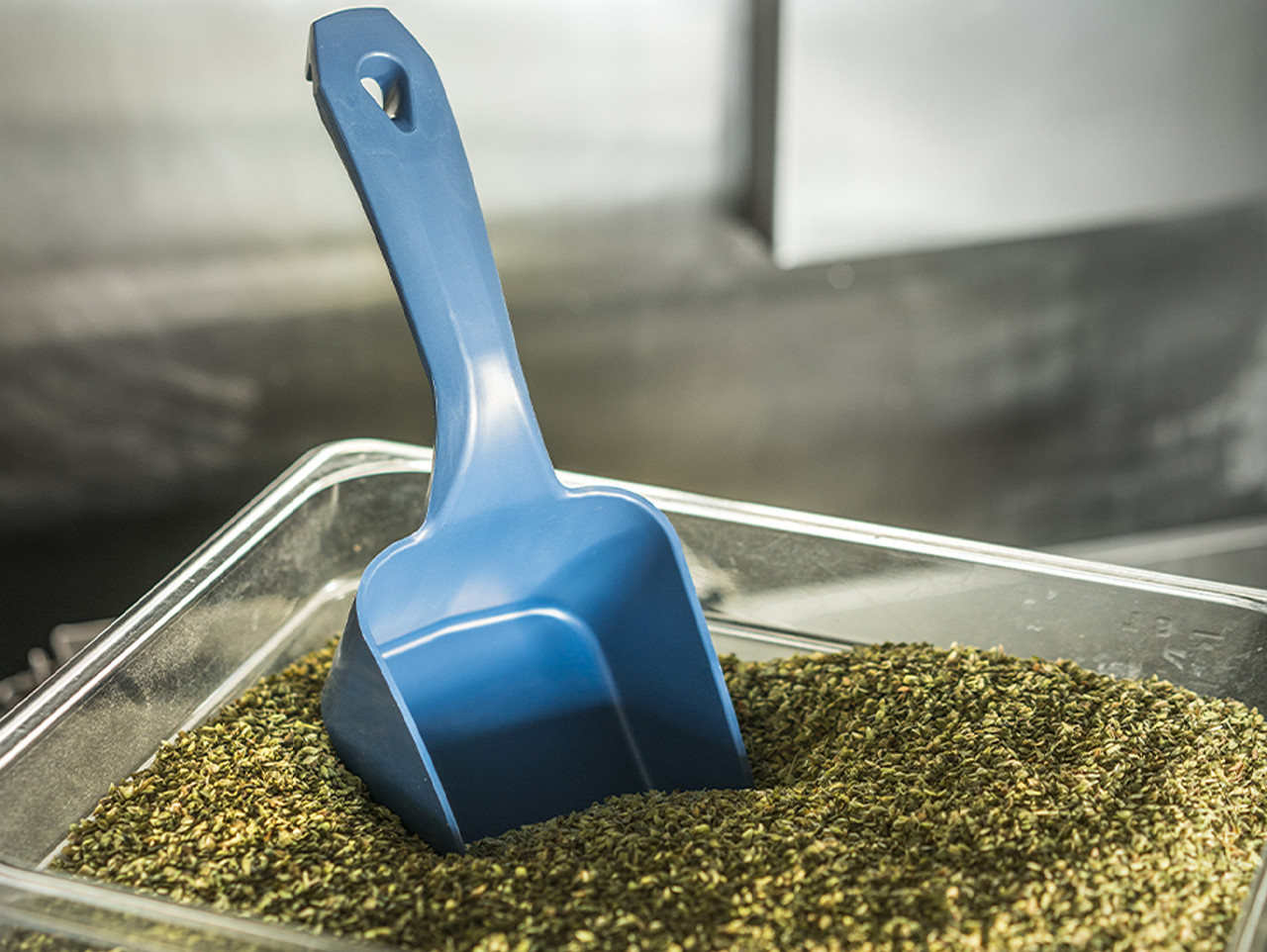We challenged you to give one, preferably as recent as possible, real-life example of a cleaning and disinfection issue you had to deal with. An event that made a deep impression on you, the biggest mistake of the year. Five companies took up the challenge and talk about a drastic hygiene issue. What happened, what caused it, and what did they learn?

"During a hygiene foodsafety scan that we offer free of charge to our relations, I came across a particularly bizarre situation. For more than 25 years I have been visiting food-producing companies, seeing all sorts of things and talking to people on the factory floor. But I was struck by what I saw the other day!
I am standing at a distance watching an employee using a hand shovel to scoop carrot cubes into the mixing tank. As soon as his norm cart is empty he walks to the kitchen to get a new one.
When he returns with his full standard cart I ask him. Where has that hand shovel gone?
Oh that hand scoop ... Well, we don't put it on the edge of the tank .... because then you run the risk of it falling in....
We do have a shadow board where we have to hang the shovel but they have placed it on the other side of the production. That was the only place where there was still room for it. There's no way I'm going to walk there 100 times a day, I don't have time for that at all. So the most convenient thing is to put the shovel on the floor next to the tank....(Aiii!)
A wet production floor is the ideal place for the pathogenic listeria bacteria to multiply deliciously. The chance of that very bacteria getting onto the hand scoop is great; an enormous food safety risk. Then you have everything well organised as a company but it still goes wrong.
We don't think in terms of problems, but in terms of solutions. We came up with a wheeled trolley where you can safely hang up the shovels close to the workplace... Simple, right?
Oh yes, don't forget: if you hang several scoops make sure that they are not directly above each other because then there is still a chance of cross contamination!"
Marc Rosendahl, food technologist and director Brillant Group
Brillant Group is more than just a specialized wholesaler, we are partners in optimal hygiene and (food) safety.
"When we are approached by a food manufacturer because microbiological results are not satisfactory, we regularly encounter a classic error. In their attempt to adjust the results and solve the problem, companies start experimenting with disinfectants. The thought behind this is: 'we will dose more' or 'we will use the disinfectant pure, then it will work better; after all, a disinfectant kills bacteria'.
This is not how it works. Disinfectants have a legal dosage guideline that accurately describes their application and dosage. The effectiveness has been tested at this dosage and soaking time. Less dosage has a negative impact on the disinfection effect and involves risks. Overdosing does not result in better or more disinfection. It does, however, lead to surface degradation, it can be dangerous for the user and it is unnecessarily harmful to the environment. Moreover, it also wastes unnecessary product. Both the dosage and the application time of the disinfectant must be right. We often find that the application time is too short, which prevents the product from doing its job optimally.
The cause of deviating microbiological results is always to be found in another corner. Sometimes mistakes are made consistently in the cleaning process. Thorough cleaning beforehand is crucial in order to be able to disinfect properly; this will remove 85 to 90% of the microorganisms. By disinfecting afterwards you can remove 99,99% of the microorganisms. Disinfecting without cleaning first is useless.
Biofilm is often the cause of abnormal results. Once you have encountered it, the problems become bigger and bigger. The solution must then be sought in specific enzymatic agents.
In a recent case in the meat industry, the cleaning frequency at critical points was too low. Also the execution was not optimal. By adjusting both factors and using the disinfectant in the right way, the problems were solved. Training and monitoring companies and cleaners remains important in our work. They must be constantly alert, aware of the importance of hygiene protocols and implementing them properly."
Jør Muller, account manager food hygiene at Christeyns
Christeyns stands for first-class cleaning products, reliable equipment and flexible, customized services. The product portfolio includes hygiene solutions for, among others, the food industry.

©ksu tumanova/Shutterstock.com
"A large international company with a number of branches in the Netherlands wanted to launch a new tender for outsourced cleaning. In preparation for this process, Eco2Clean Consultancy was asked to update the cleaning plan of all branches." Eco2Clean Consultancy offers food companies, independent of the supply of products, customized support in the field of hygiene and cleaning issues.
The situation was quite fragmented. The cleaning plan was partly carried out by an external cleaning company and partly by employees of the company itself. In one of the sites, the cleaning plan had been updated fairly recently by the cleaning company. We therefore expected this plan to be virtually up-to-date. However, our check yielded a surprising result.
The site had been thoroughly renovated three years ago. One department had been completely demolished. A new department had been built in its place. To our surprise, we found that the demolished department was still being cleaned (on paper); it even had daily checklists! The new department, on the other hand, did not appear in the cleaning plan. Where had it gone? Upon inquiry, it turned out that the new section was being cleaned daily.
The invoices from the cleaning company clarified the matter. Checking these showed that the department (which had not existed for three years) was still being invoiced. The work in the new department was listed as 'extra work performed'. No one properly checked the cleaning plan, or the invoices. The mistake cost the company several tons. A good lesson: always have a good and up-to-date cleaning plan; for both outsourced and in-house cleaning.
This is, of course, an extreme example. Yet in practice few companies keep their cleaning plan up-to-date. This can have considerable consequences. In every company there are continuously large and small changes that structurally affect the plan. Think for example of a new machine or a change in production. In the delusion of the day it is easy to forget that this affects the cleaning plan, and therefore it must be adjusted.
A cleaning plan is dynamic. Keeping it up to date requires discipline and a time investment. Therefore, have the plan checked periodically! Prevent company blindness and preferably choose an external party for this task. You will ultimately save money and limit possible hygiene risks."
Gert Visscher, director/owner Eco2Clean
Eco2Clean has supplied the food industry with high-quality cleaning and disinfection products for over 20 years (over 500 customers) and is a knowledge partner in the field of hygiene and cleaning.
One of our business relations, a meat processor, had landed a new client after an intensive tender round; a major client from the convenience world. He announced that he would regularly have inspections performed on various KPIs of the meat processor. He was in possession of various certifications and had his own quality service and was not concerned about this.
The quality service performed regular checks on the hygiene delivered, which, incidentally, was provided by an external cleaner. Visually it always looked very clean. The bacteriological results of the swap and agar measurements were always good to excellent. The measurements were carried out by different people from the quality department, always without prior notice, in order to have an objective picture of the overall hygiene as a basis for shelf life and quality.
At the very first unannounced inspection by the new customer, however, it was immediately wrong. Significant deviations from the bacteriological results were noted. This had to be an incident! The internal checks were intensified. No deviations from the norm were found. Not much later a second unannounced inspection followed. BINGO. Once again, deviations in bacteriology. An official warning followed immediately. And the company not only had to substantiate the cause of the deviation, the problem had to be solved within a week.
The external cleaning company was at a loss as to what to do; they could not find the cause. The quality manager, an old friend, called me with some panic: "This could lead to the loss of a major customer! And possibly even more misery..."
We went to work, analyzing the measuring moments and the results, checking the concentration of the cleaning agents used, the contact times of disinfection and the method of cleaning. It did not produce a directly identifiable cause. We therefore decided to join the cleaning team for an evening.
During the on-the-job checks we quickly discovered the cause. To prevent ice from forming, the cooling engines were turned off in almost every room during the cleaning. A few hours after the cleaning, during the inspection round by the quality department, they were switched on again to guarantee a clean and cool start of production. These space cooling units, including the evaporators in cold rooms and freezer cells, were cleaned only sporadically; only during maintenance by the refrigeration technicians. As a result, the drip trays under the evaporators were filled with a mix of algae, yeasts, fungi and bacteria. Every evening this mix was fed with fresh, warm vapor of water and spatial flora and fauna from the high-pressure sprayers of the cleaners (unaware of any harm).
The solution: a simple cleaning of all evaporators with an enzymatic (pH-neutral) cleaner that does not corrode the ultra-thin cooling fins. The enzymes give a deep clean, so disinfection is not necessary (the breeding ground for bacteria etc. is after all no longer present). This operation naturally became a regular part of the cleaning plan at an appropriate frequency. All's well that ends well.
Learning point: regular cleaning of evaporators is an essential part of total hygiene."
Hans Groenink, Director of Cura Biotech
Cura Biotech BV develops and supplies hygiene solutions for the food industry based on biotechnology.

©Wayhome studio/Shutterstock.com
"In a powder plant of one of our clients, water/moisture is detected in a powder silo. All installations in the packaging department are filled with a custard-like substance instead of powder. It is a so-called Dryblend site. Regular cleaning must be performed here without water. Think of wiping the installations with microfiber cloth, and vacuuming. In such a plant, in addition to the end product, the entire environment must meet specific bacteriological standards.
The cause of the problem turns out to be a broken moisture meter. This normally measures the moisture percentage. If the powder becomes too moist, an alarm goes off and the process towards the packaging department is blocked. The defect was not signaled. The effect of this calamity was that the bacteriological results of the environment were too high for a long time. Due to the moisture, vacuum cleaning was no longer possible and dirt removal with microfiber cloths proved insufficient. How could we get the environment back to the right level without adding moisture to the cleaning process?
We had to develop a different cleaning method. We did that in cooperation with the parties involved: QA, production, technical support and cleaning. By sharing our expertise we came up with the solution: 'Controlled Wet Cleaning'. This means that with minimal use of water to which a disinfectant is added, we succeeded in bringing the results back to the desired level.
The most important lesson we learned as a result of this calamity? That by combining the knowledge and expertise of all the parties involved in the production process, you can find a solution. Moreover, cooperation leads to broad-based support. It was decided together that, in addition to the regular cleaning, the new Controlled Wet Cleaning method would be used preventatively on a weekly basis in order to eliminate possible risks and to secure the desired results."
Twan Voets, Commercial Director Hago Food & Industry B.V.
Cleaning company Hago stands for customised cleaning. Cleaning without you having to worry about it. Thinking along and acting proactively on the basis of your own professional specialism. Combining customer knowledge with professional expertise.
Source: Vakblad Voedingsindustrie 2021